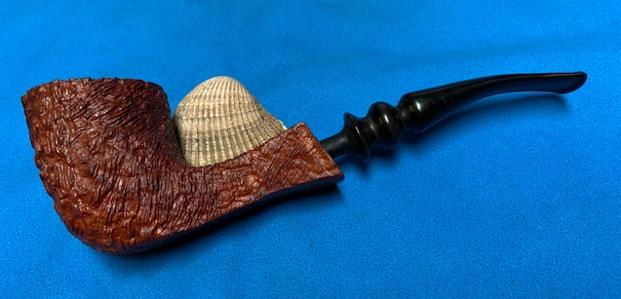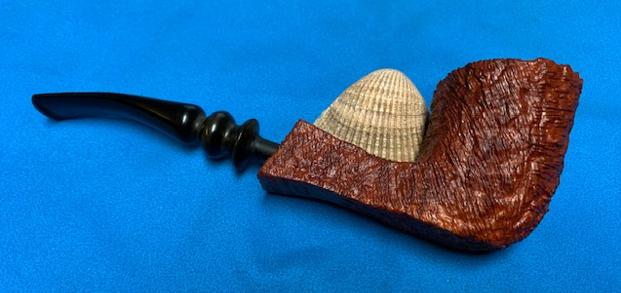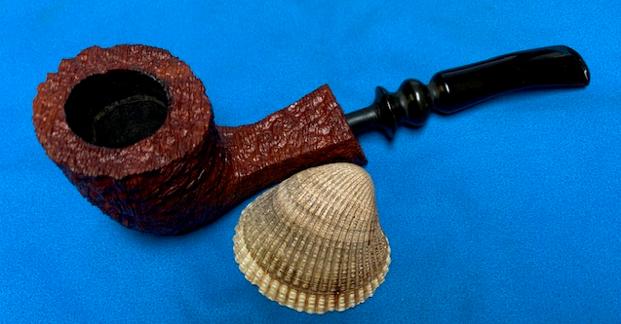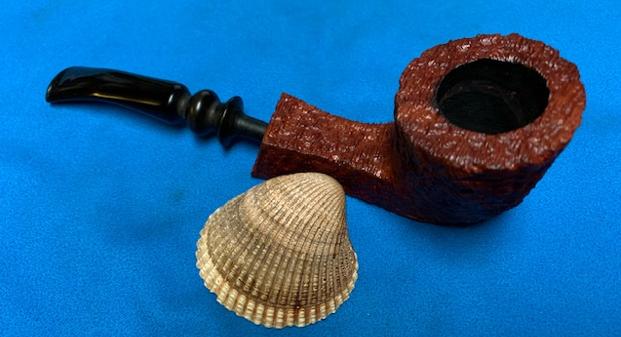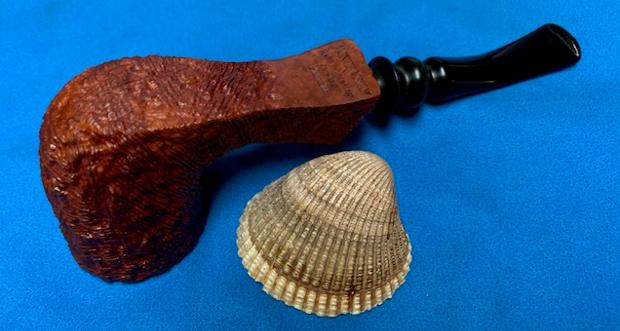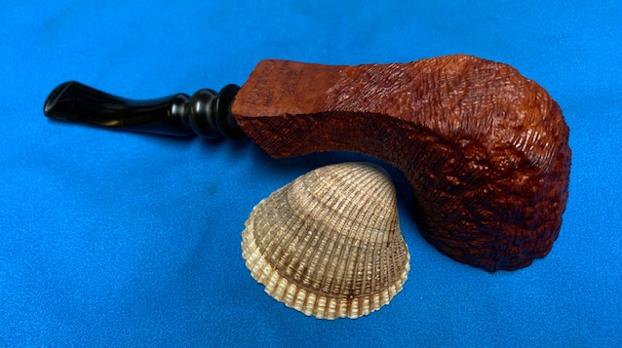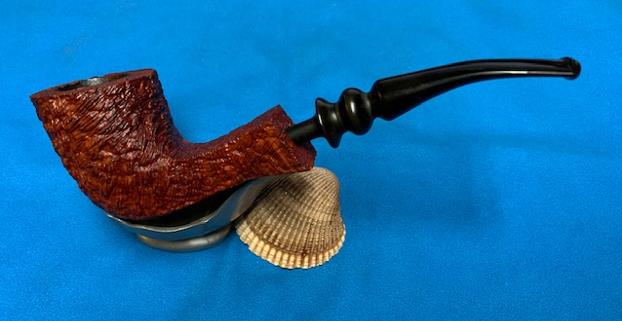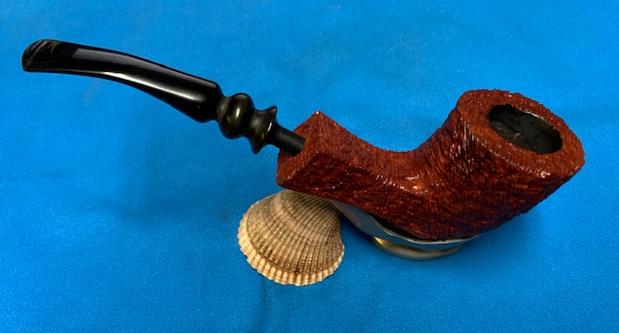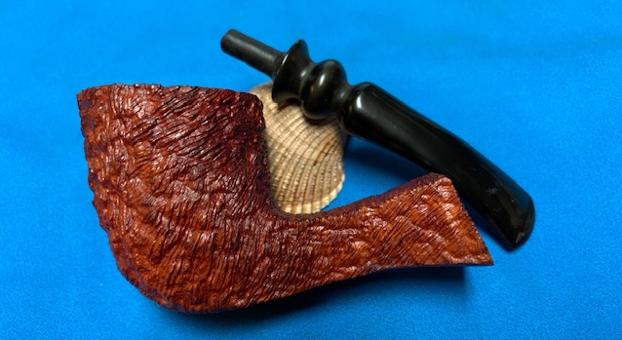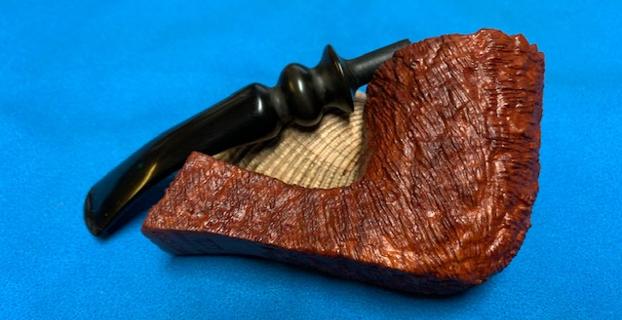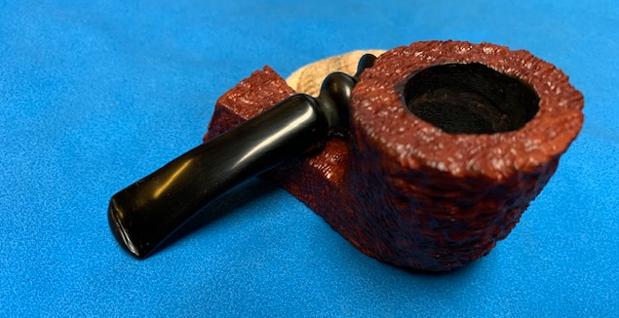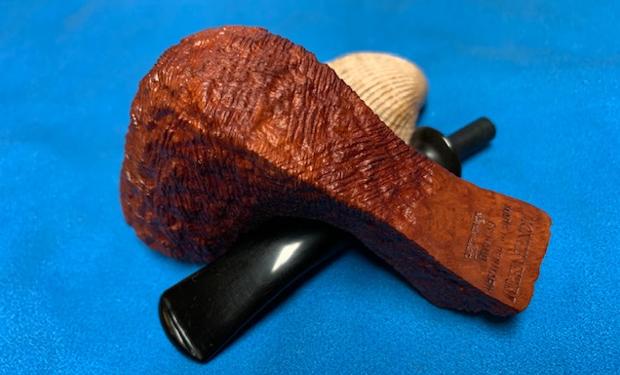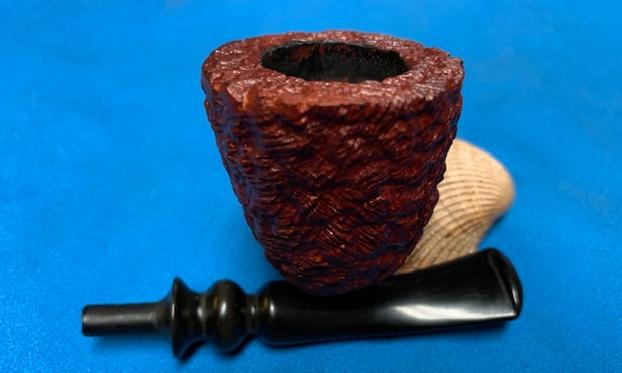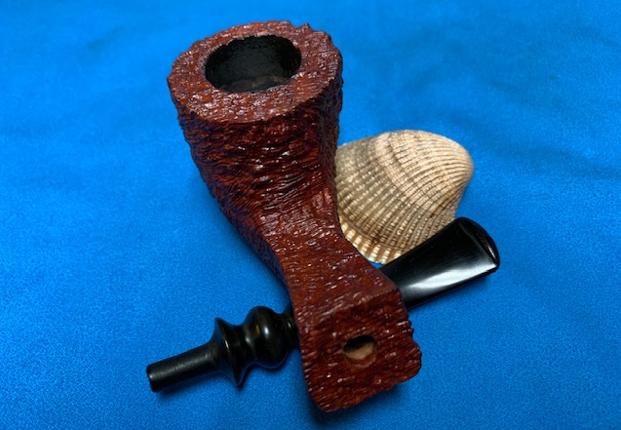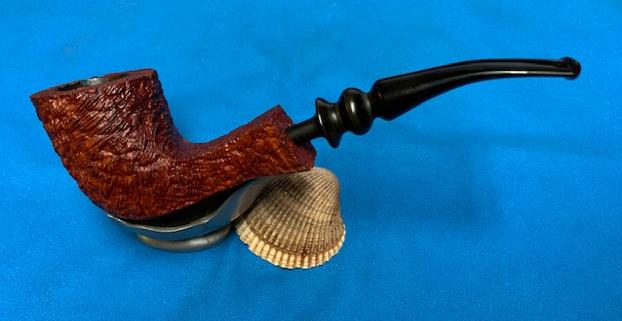Blog by Steve Laug
The next pipe I chose to work on was a Monte Verde bowl sans stem that was purchased from an online auction on 03/06/18 from Nampa, Idaho, USA. It has been sitting in my box of bowls since that time. Jeff cleaned it up and mailed it to me. I have been postponing restemming any of the pipes for a while now but after restemming that little gourd calabash a couple of days ago I was ready to do a few more. I pulled this one out of the box first and set aside to be the next pipe to work on. It has a very craggy rustication that is quite stunning and a square flared shank. Overall it is a pretty pipe. The bowl had thick cake in the bowl and the rim top had a coat of lava on the inner edge of the bowl and in the grooves of the rim top. The finish had a lot of dust and debris in the valleys of the rustication. The stamping on the smooth panel on the underside of the shank was clear and readable. It was stamped Monte Verdi [over] Made in Denmark [over] By Hand [over] Golden Tan in script. I knew that the Monte Verdi line was made by Preben Holm of Ben Wade and Preben Holm Freehand fame. Jeff took some photos of the bowl before he cleaned it up.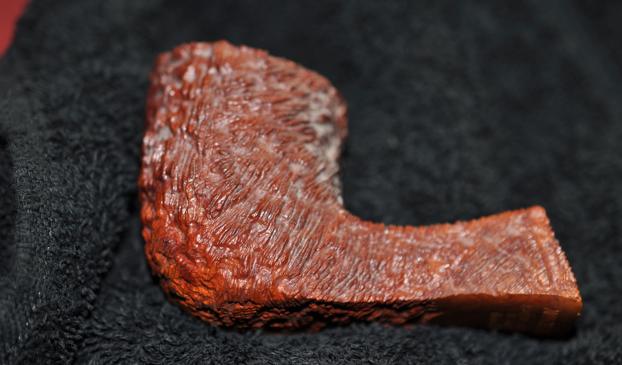
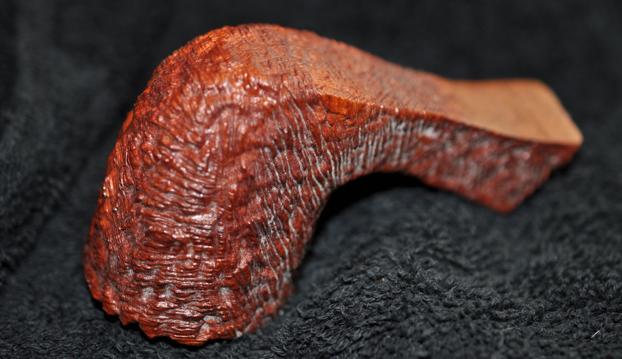 The next two close up photos show the condition of the bowl and rim top. You can see the lava coat on the inner edge of the bowl and the debris in the rustication of the rim top.
The next two close up photos show the condition of the bowl and rim top. You can see the lava coat on the inner edge of the bowl and the debris in the rustication of the rim top. 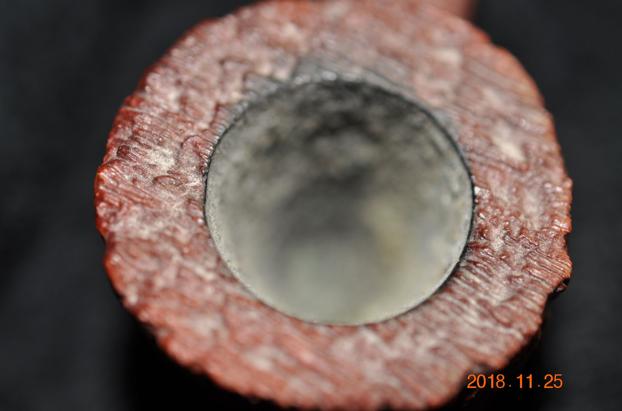
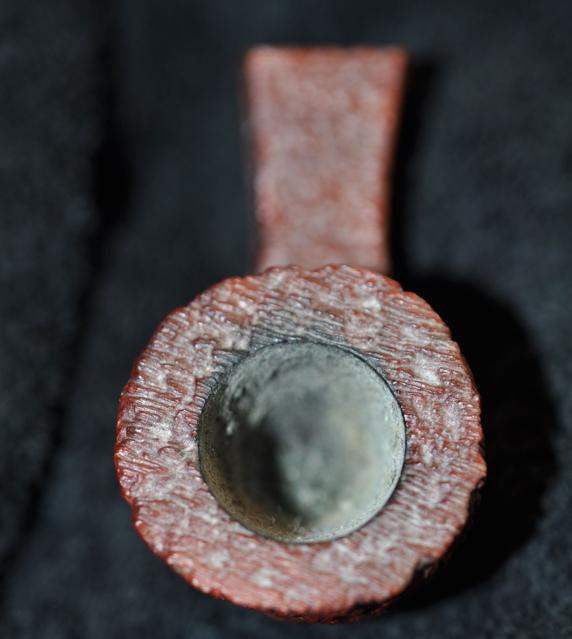 Jeff took a photo of the stamping on the underside of the shank. It read as noted above and is clear and readable.
Jeff took a photo of the stamping on the underside of the shank. It read as noted above and is clear and readable.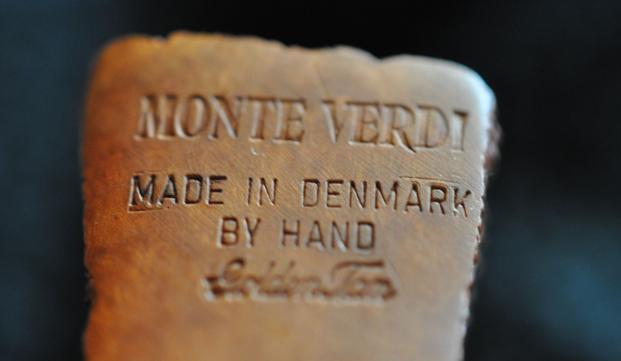 I decided to confirm my thinking that the pipe was connected with Preben Holm/Ben Wade. I turned to Pipephil’s site to get a read on the brand (http://pipephil.eu/logos/en/logo-m6.html). Sure enough the Monte Verdi line was made by Preben Holm. The pipe in the photo had a very similar rustication to the Monte Verdi bowl I was working on. I did a screen capture of the section on Pipephil. I have included it below.
I decided to confirm my thinking that the pipe was connected with Preben Holm/Ben Wade. I turned to Pipephil’s site to get a read on the brand (http://pipephil.eu/logos/en/logo-m6.html). Sure enough the Monte Verdi line was made by Preben Holm. The pipe in the photo had a very similar rustication to the Monte Verdi bowl I was working on. I did a screen capture of the section on Pipephil. I have included it below. 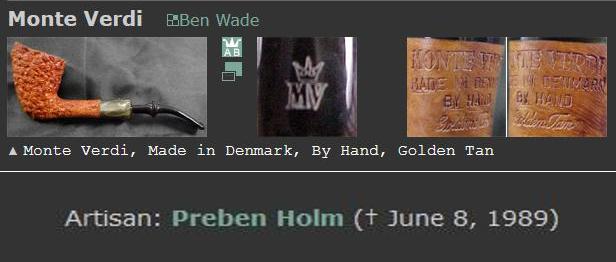 There were also photos that were included on Pipephil of what this particular pipe looked like when it had left Denmark. The rustication around the bowl and shank is very similar. The pipe I have does not have a shank extension but otherwise the finish is much the same.The pipe originally had a fancy turned vulcanite stem. The stem was long gone when Jeff picked it up so I had some decisions to make about the stem I would use to restem it.
There were also photos that were included on Pipephil of what this particular pipe looked like when it had left Denmark. The rustication around the bowl and shank is very similar. The pipe I have does not have a shank extension but otherwise the finish is much the same.The pipe originally had a fancy turned vulcanite stem. The stem was long gone when Jeff picked it up so I had some decisions to make about the stem I would use to restem it.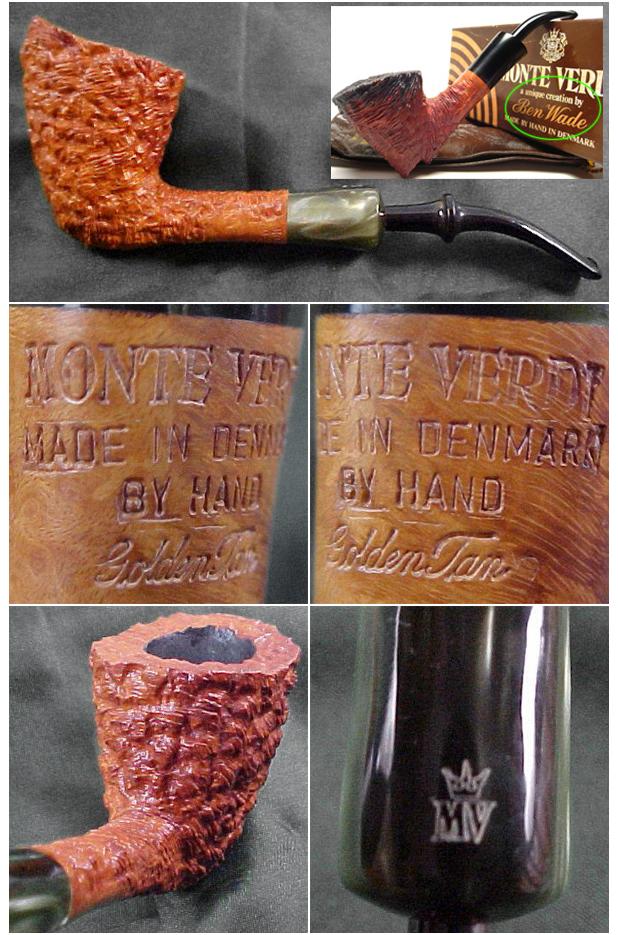 I turned to work on the pipe itself. Jeff had carried out his usual thorough cleanup of the pipe. He had reamed it with a PipNet reamer to remove the cake and cleaned the reaming up with a Savinelli Fitsall Pipe Knife. He scrubbed the internals of the bowl and stem with alcohol, cotton swabs and pipe cleaners. He scrubbed the externals with undiluted Murphy’s Oil Soap and rinsed the bowl off with running water. The pipe looked very clean when I received it.
I turned to work on the pipe itself. Jeff had carried out his usual thorough cleanup of the pipe. He had reamed it with a PipNet reamer to remove the cake and cleaned the reaming up with a Savinelli Fitsall Pipe Knife. He scrubbed the internals of the bowl and stem with alcohol, cotton swabs and pipe cleaners. He scrubbed the externals with undiluted Murphy’s Oil Soap and rinsed the bowl off with running water. The pipe looked very clean when I received it. 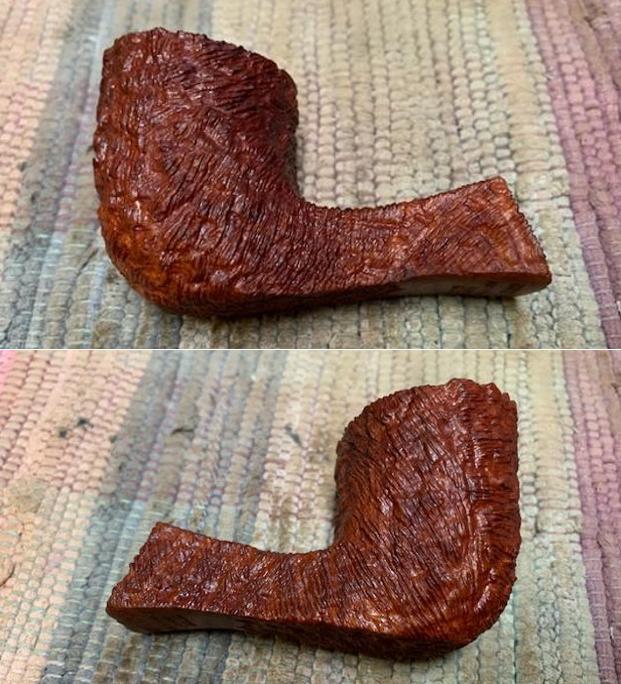
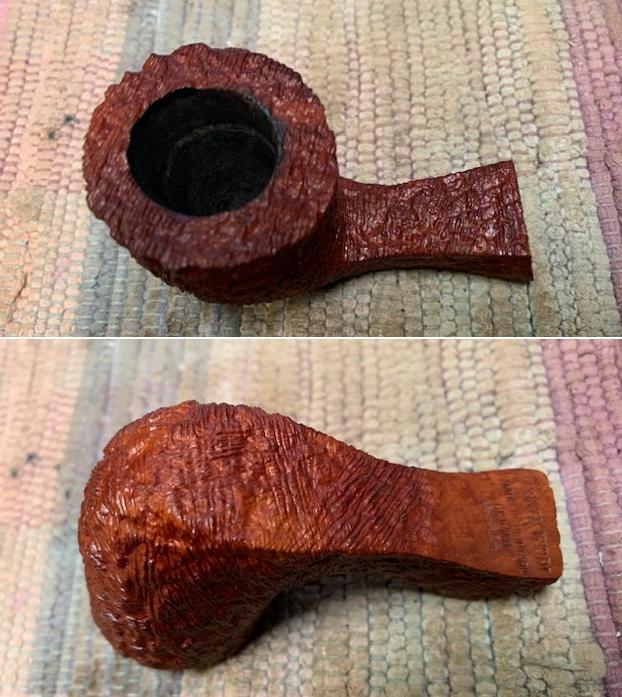 The rim top and shank end cleaned up really well as can be seen in the close up photos below.
The rim top and shank end cleaned up really well as can be seen in the close up photos below.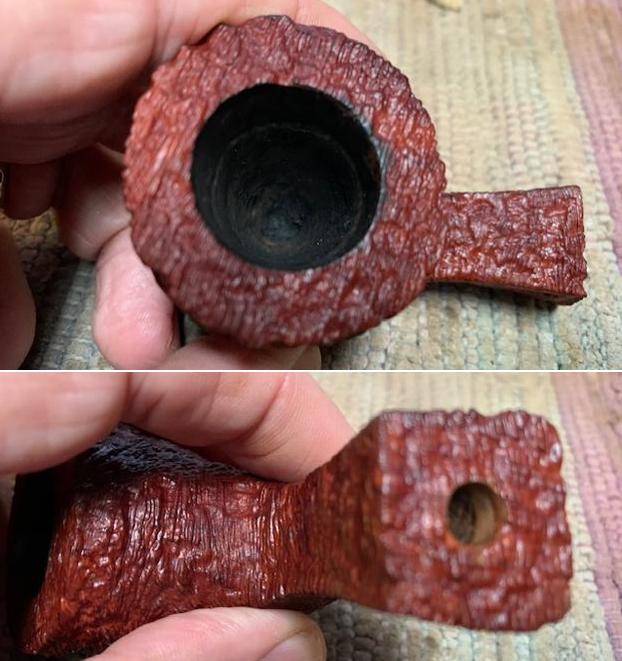 I took a photo of the stamping on the underside of the shank. It really is clear and readable.
I took a photo of the stamping on the underside of the shank. It really is clear and readable.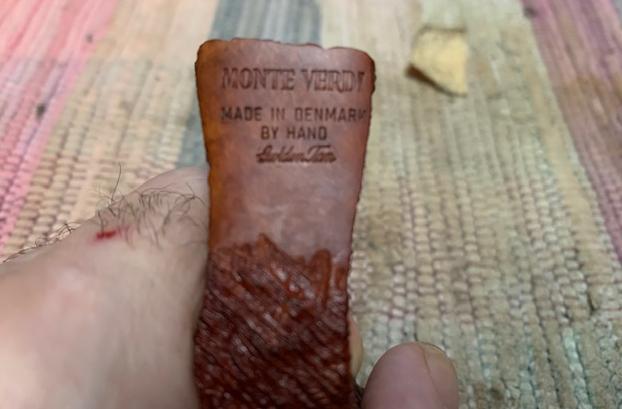 I went through my can of stems and found turned freehand style vulcanite stem that would work well with the bowl and shank. The bend in it was perfect. There were tooth marks in surface of the top and underside of the stem at the button that would need to be dealt with in the restoration.
I went through my can of stems and found turned freehand style vulcanite stem that would work well with the bowl and shank. The bend in it was perfect. There were tooth marks in surface of the top and underside of the stem at the button that would need to be dealt with in the restoration. 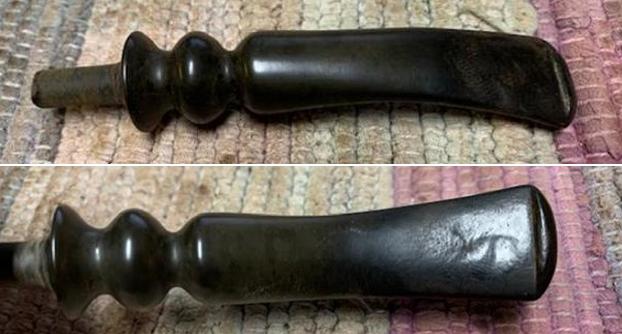 I took a photo of the stem and bowl together to give a sense of the look of the pipe and the proportion of the stem.
I took a photo of the stem and bowl together to give a sense of the look of the pipe and the proportion of the stem. 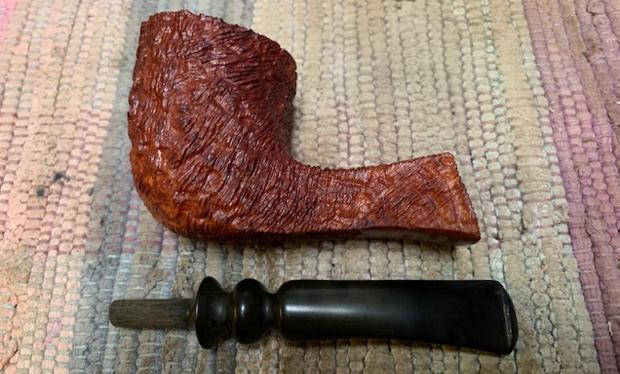 I shortened the length of the tenon with my Dremel and sanding drum and smoothed out the tenon with 220 grit sandpaper and fit the stem in the shank and took pictures of the pipe and stem.
I shortened the length of the tenon with my Dremel and sanding drum and smoothed out the tenon with 220 grit sandpaper and fit the stem in the shank and took pictures of the pipe and stem.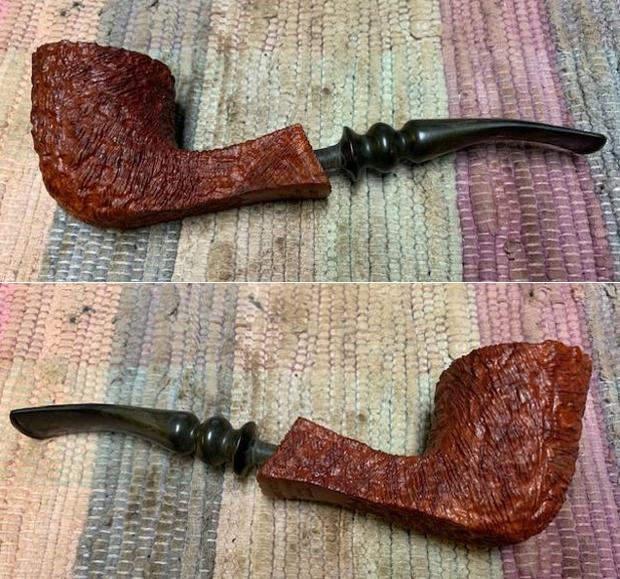
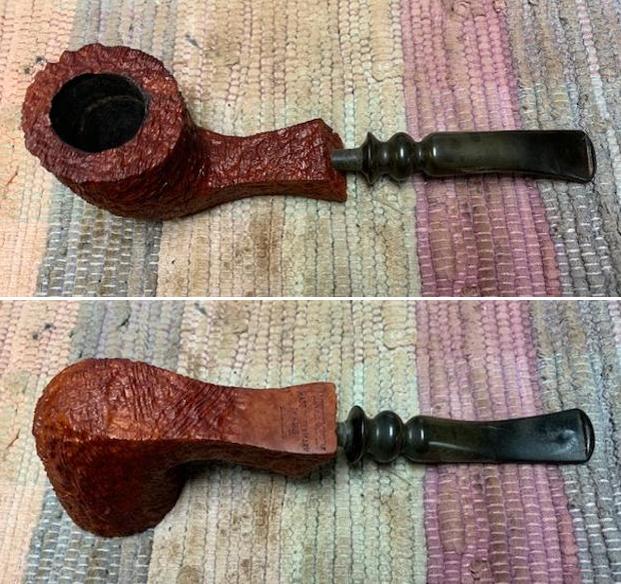 I removed the stem and rubbed the briar down with Before & After Restoration Balm. I worked it into the briar with my fingertips and a horsehair shoe brush. The product works to clean, enliven and preserve the briar. I let it sit for 15 minutes while I worked on the stem. After the time passed I buffed it with a cotton cloth to deepen the shine. The briar really comes alive with the balm.
I removed the stem and rubbed the briar down with Before & After Restoration Balm. I worked it into the briar with my fingertips and a horsehair shoe brush. The product works to clean, enliven and preserve the briar. I let it sit for 15 minutes while I worked on the stem. After the time passed I buffed it with a cotton cloth to deepen the shine. The briar really comes alive with the balm. 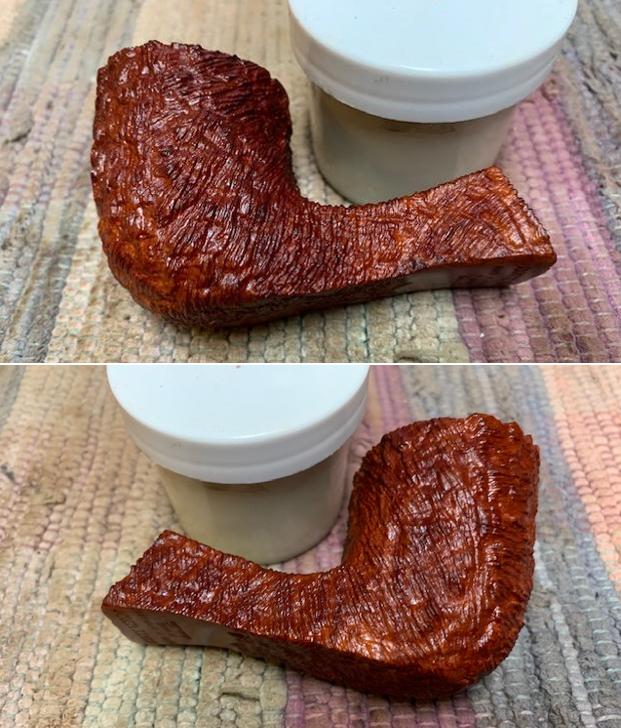
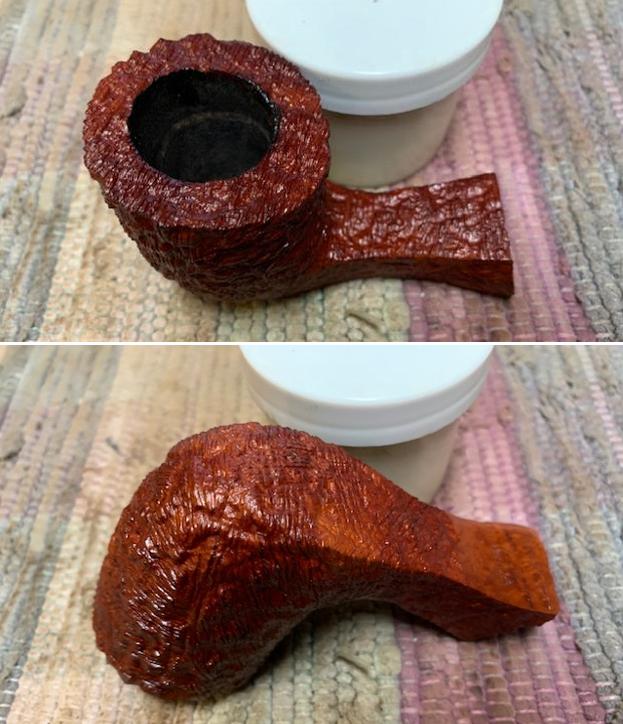
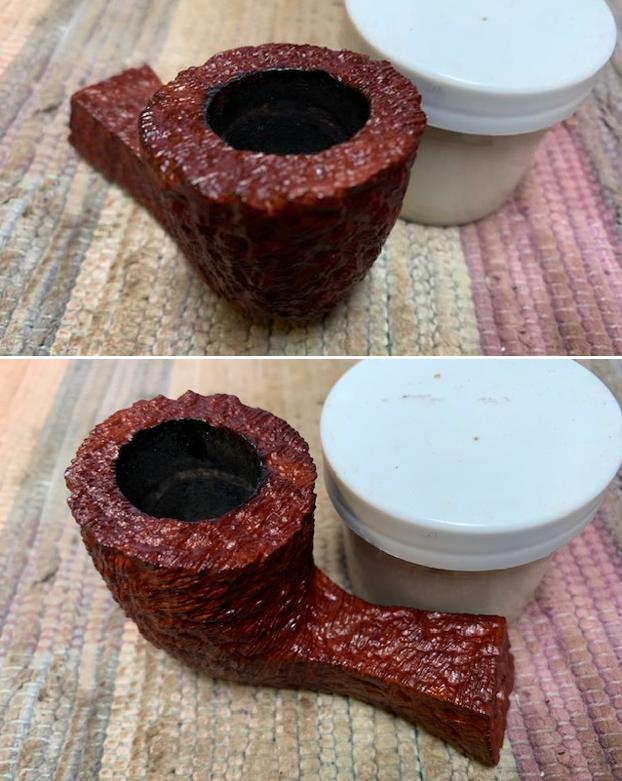 I set the bowl aside and turned my attention to the stem. I “painted” the tooth marks on both sides of the stem with the flame of a lighter to lift them as much as possible. I filled in the tooth marks that remaining with clear super glue and set it aside to cure. Once it had cured I used a flat file to reshape the edge of the button and flatten the repairs on the stem surface. I blended the repairs into the surface of the vulcanite with 220 grit sandpaper. I started polishing the stem with 400 grit wet dry sandpaper. The stem was looking much better.
I set the bowl aside and turned my attention to the stem. I “painted” the tooth marks on both sides of the stem with the flame of a lighter to lift them as much as possible. I filled in the tooth marks that remaining with clear super glue and set it aside to cure. Once it had cured I used a flat file to reshape the edge of the button and flatten the repairs on the stem surface. I blended the repairs into the surface of the vulcanite with 220 grit sandpaper. I started polishing the stem with 400 grit wet dry sandpaper. The stem was looking much better.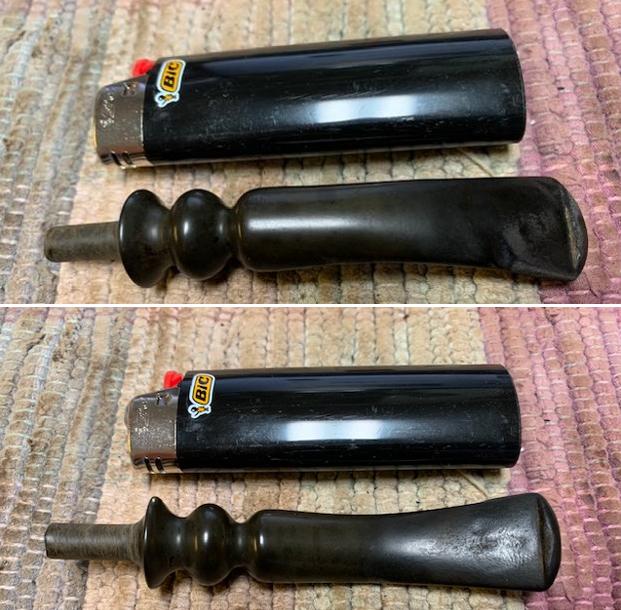
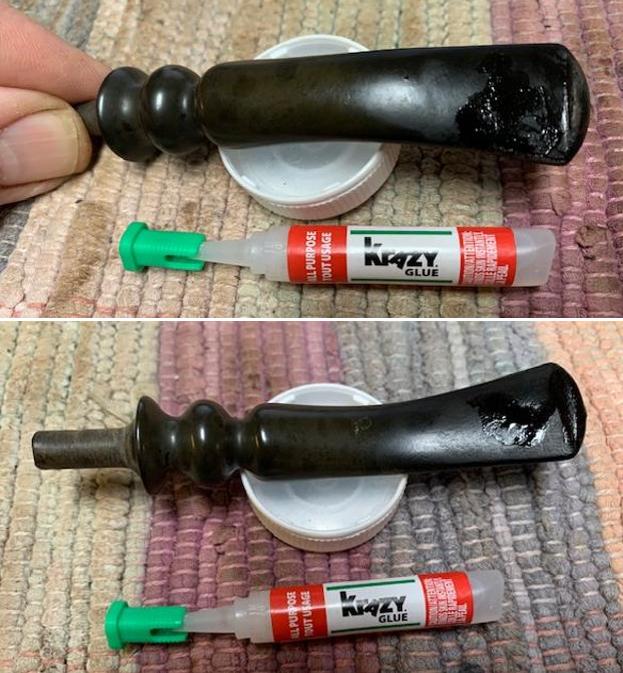
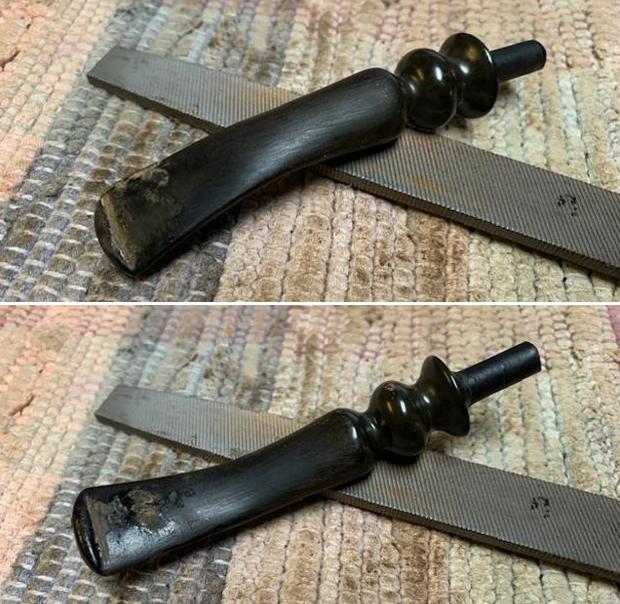
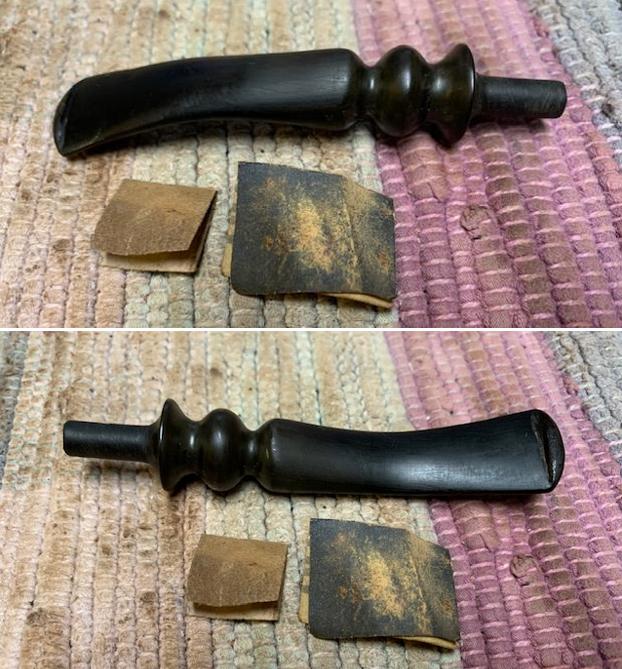 I polished the vulcanite with micromesh sanding pads – 1500-12000 grit pads. I wiped it down with Obsidian Oil after each sanding pad. I used Before & After Pipe Polish – both Fine and Extra Fine to further polish the stem.
I polished the vulcanite with micromesh sanding pads – 1500-12000 grit pads. I wiped it down with Obsidian Oil after each sanding pad. I used Before & After Pipe Polish – both Fine and Extra Fine to further polish the stem. 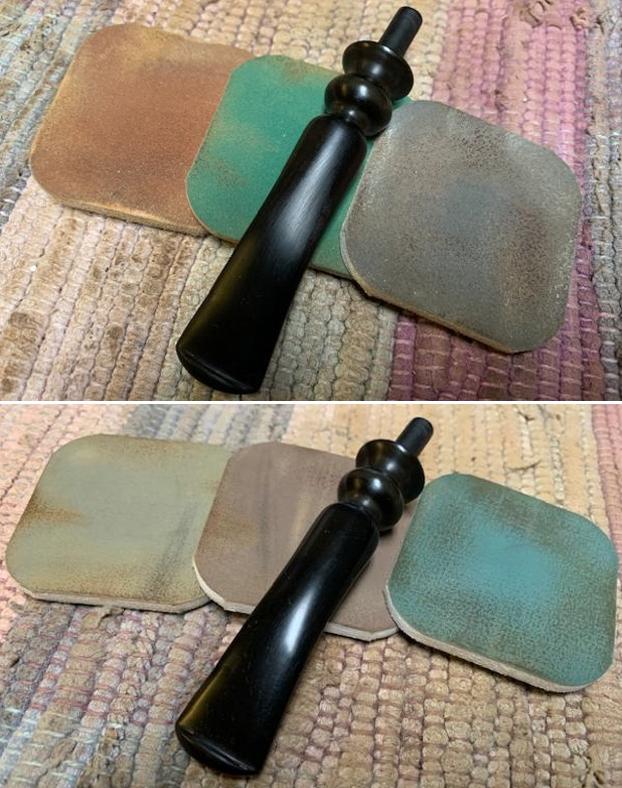
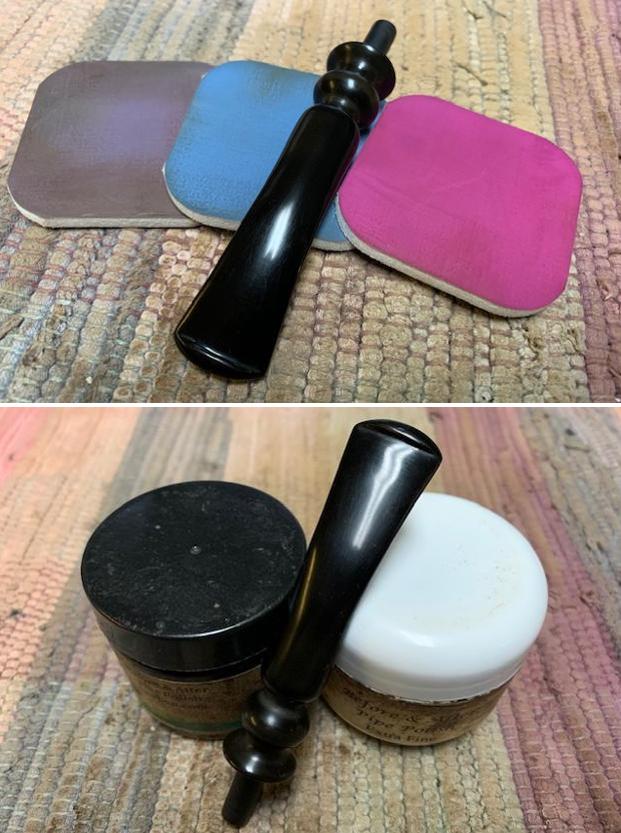 In speaking with Kenneth yesterday I remembered that I had used a product in the past called Meguiar’s Scratch X2.0 to polish the surface of the stem after all of the previous polishing I had done. I took photos of the stem after polishing with the compound and did give a rich shine.
In speaking with Kenneth yesterday I remembered that I had used a product in the past called Meguiar’s Scratch X2.0 to polish the surface of the stem after all of the previous polishing I had done. I took photos of the stem after polishing with the compound and did give a rich shine. 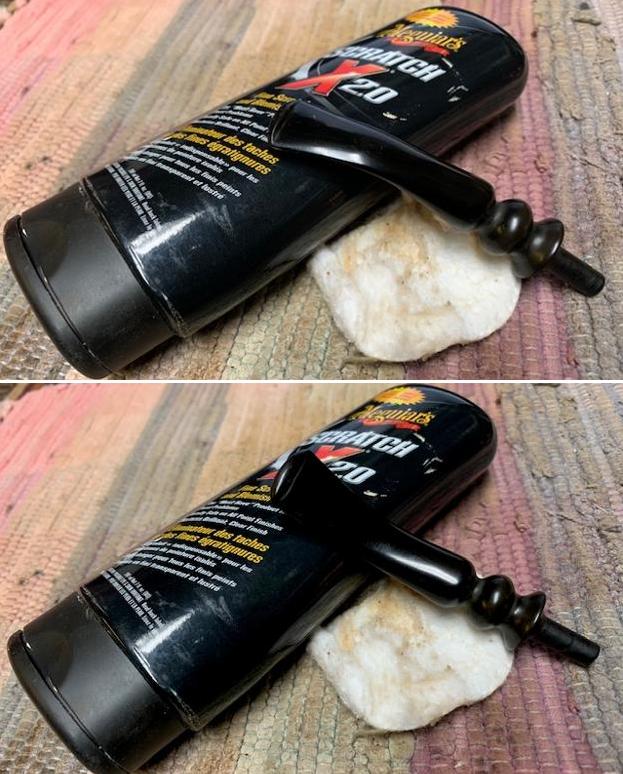 This restemmed, rusticated Preben Holm Hand Made Monte Verdi Golden Tan Freehand is a beautiful looking pipe that combines a rusticated finish with a unique shaped. The brown stains on the bowl work well to highlight the finish. The polished turned fancy black vulcanite stem adds to the mix. I put the finished stem on the bowl and buffed it with Blue Diamond on the buffing wheel being careful to not buff the stamping. I gave the bowl multiple coats of Conservator’s Wax and the stem multiple coats of carnauba wax on the buffing wheel and followed that by buffing it with a clean buffing pad. I hand buffed the pipe with a microfiber cloth to deepen the shine. The finished pipe is quite nice and feels great in the hand. Give the finished pipe a look in the photos below. I can only tell you that like the other pipes I am working that it is much prettier in person than the photos capture. The dimensions of the pipe are Length: 7 inches, Height: 2 inches, Outside diameter of the bowl: 1 ¾ inches, Chamber diameter: 7/8 of an inch. The weight of the pipe is 63grams/2.22oz. It will soon be added to the Danish Pipe Makers section on the rebornpipes store. Thanks for walking through the restoration with me as I worked over another beautiful pipe. Remember we are not pipe owners; we are pipemen and women who hold our pipes in trust until they pass on into the trust of the next generation.
This restemmed, rusticated Preben Holm Hand Made Monte Verdi Golden Tan Freehand is a beautiful looking pipe that combines a rusticated finish with a unique shaped. The brown stains on the bowl work well to highlight the finish. The polished turned fancy black vulcanite stem adds to the mix. I put the finished stem on the bowl and buffed it with Blue Diamond on the buffing wheel being careful to not buff the stamping. I gave the bowl multiple coats of Conservator’s Wax and the stem multiple coats of carnauba wax on the buffing wheel and followed that by buffing it with a clean buffing pad. I hand buffed the pipe with a microfiber cloth to deepen the shine. The finished pipe is quite nice and feels great in the hand. Give the finished pipe a look in the photos below. I can only tell you that like the other pipes I am working that it is much prettier in person than the photos capture. The dimensions of the pipe are Length: 7 inches, Height: 2 inches, Outside diameter of the bowl: 1 ¾ inches, Chamber diameter: 7/8 of an inch. The weight of the pipe is 63grams/2.22oz. It will soon be added to the Danish Pipe Makers section on the rebornpipes store. Thanks for walking through the restoration with me as I worked over another beautiful pipe. Remember we are not pipe owners; we are pipemen and women who hold our pipes in trust until they pass on into the trust of the next generation.